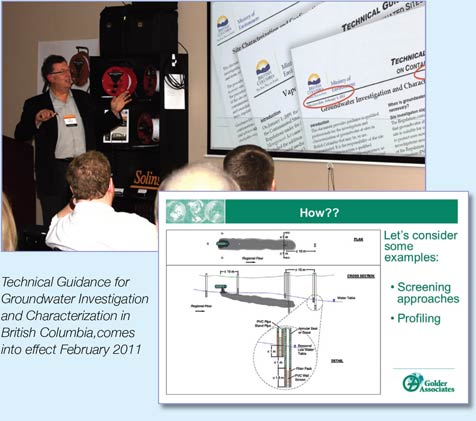 Guy Patrick had the Symposium audience fully engaged with his presentation of the new site characterization guidance document for British Columbia. The new guidance is designed to allow environmental consultants to meet government requirements, as well as meet monetary and time constraints put on them by clients.
Guy Patrick had the Symposium audience fully engaged with his presentation of the new site characterization guidance document for British Columbia. The new guidance is designed to allow environmental consultants to meet government requirements, as well as meet monetary and time constraints put on them by clients.
It aims to do this by providing answers to important site characterization questions, including:
- When is groundwater investigation necessary?
- How do you design the field program?
- What is a conceptual site model?
- What about LNAPL and DNAPL?
- What level of investigation is necessary?
- What are acceptable methods and approaches?
The approaches set out in the guidance favour those that increase the amount of spatial and temporal data, as well as chemistry, with the overall objective of creating a larger three-dimensional data set.
The guidance also aims to correct common issues seen throughout the industry, such as not enough monitoring wells at a site, the use of long screened wells that average groundwater chemistry, and not enough sampling. These issues lead to erroneous conceptual models being created, and therefore the wrong conclusions and decisions made.
Guy hopes this document will ultimately even-out the playing field for the consulting industry in the province, and reduce the number of “professional judgement” decisions made during site characterizations, and replace them with decisions based on accurate, representative data.
ABOUT THE SPEAKER
 Guy C. Patrick, P.Eng., M.Sc,
Guy C. Patrick, P.Eng., M.Sc,
Principal, Golder Associates Ltd.
With over 25 years in environmental consulting, Mr. Patrick provides senior technical review and direction for environmental investigations, sediment remediation strategies, groundwater protection plans and remedial projects across Canada and globally. His work has focussed on soil, sediment and groundwater contamination issues and risk management strategies at solid waste, industrial and commercial facilities containing dense liquids (DNAPLs) such as creosote, coal-tar, and chlorinated solvent (e.g., PCE and TCE,) as well as petroleum hydrocarbons and metals. Mr. Patrick is a Senior Hydrogeologist and Principal with Golder Associates Ltd. in BC and a Registered Professional Engineer in BC, the Yukon, Saskatchewan, and Nova Scotia. He serves as a board member of the Contaminated Sites Approved Professionals (CSAP) society in BC, and is a frequent speaker at conferences and educational institutions.
